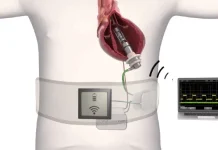Eko Health is souping up an old technology for a powerful new way to help detect early signs of heart failure.
Eko won FDA clearance for an algorithm powered by artificial intelligence — built with Mayo Clinic — using Eko’s digital stethoscopes for sound and electrocardiogram (ECG) sensing.
Related: CVRx has more data supporting long-term benefits of Barostim
“The three legs of the stool for us are the device, the software, and then the disease-detection algorithms,” Eko Health co-founder and CEO Connor Landgraf said in an interview. “The devices have a longer manufacturing and development time given the hardware involved. We choose a set of sensors and capabilities, and then the goal is to be able to create as many meaningful disease-detection capabilities and algorithms using those sensing modalities. … One of the bigger focus areas for us has been how much signal and value can you extract from the combination of audio and ECG.”
Eko focused on acoustics and ECG to sense the heart’s rhythm and mechanical function — electrical activity of the heart muscle, then blood flow and the valve closure — and synchronize those two signals to provide hemodynamic parameters that wouldn’t be possible by just capturing each of those signals individually.
Eko’s digital stethoscopes — the Eko Duo and Eko Core 500 — have three ECG electrodes and synchronized acoustic sensing for simultaneous readings. Eko already had regulatory approval for identifying structural heart murmurs and arrhythmia detection.
The newest algorithm uses those same ECG and audio sensors to identify patients with reduced ejection fraction. Ejection fraction is typically measured from echocardiography, cardiac MRIs or other other imaging studies looking at the left ventricle’s size to estimate the percent of blood that moves out of the ventricle during contraction.
“In those cases where you have weak heart muscle, there are signals that are going to show up in ECG and there are signals that are going to show up in the acoustics that indicate not everything is well with the heart muscle and the left ventricle is maybe failing or insufficient,” Landgraf said. “We’re able to pick up those signals. … We believe it’s five or six different signals that the algorithm is able to identify and then come up with a likely value of whether the patient has normal or reduced [ejection fraction].”
The algorithm doesn’t produce a specific numeric value for ejection, but instead uses a cutoff threshold to say whether it’s above or below 40%.
“That’s the primary output from this algorithm,” he said. “It works quite well as an early detection tool for patients who might have a weak heart pump. And what we know about heart failure is these patients often have it for extended periods of time before they start showing real symptoms or the early symptoms are very subtle and many patients don’t really pay attention to them.”
When those patients aren’t diagnosed or treated, their disease progresses.
“We believe this technology can be a really powerful aid to the physician who’s evaluating a patient who has early, nonspecific symptoms,” Landgraf said. “We just want to get the right patients to cardiology sooner and make sure we don’t miss any patients. We’re not trying to diagnose them now. We’re trying to get them to the right diagnostics.”






